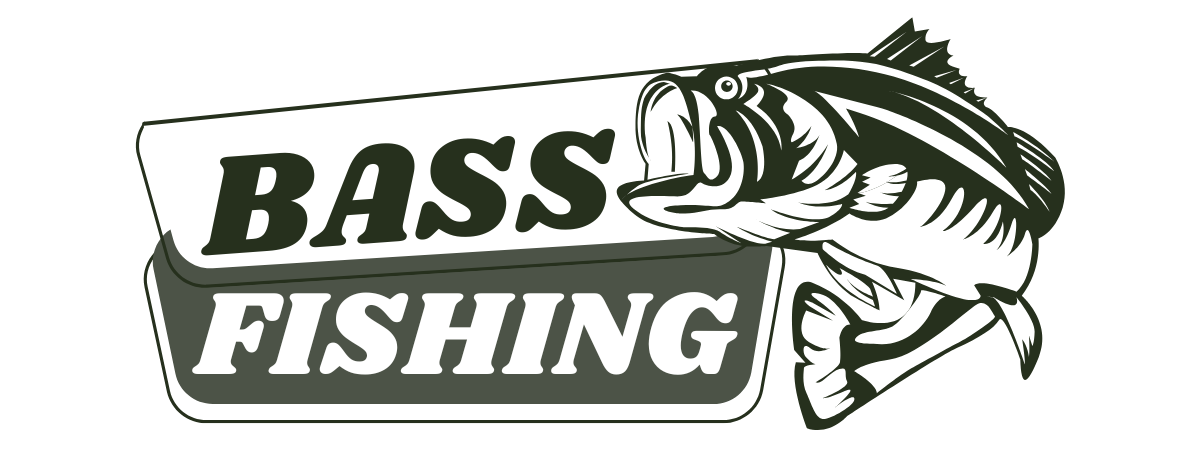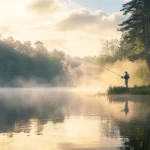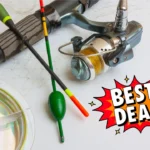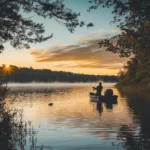
Introduction: More Than a Line in the Water
The sun rises, casting golden rays across the still water. You feel the pull, the subtle twitch at the end of your line. It’s a moment of pure anticipation, a connection with nature that’s as thrilling as it is serene. This is the essence of bass fishing – it’s not just about tossing a line into the water and waiting; it’s a complex blend of strategy, patience, and a deep understanding of the aquatic world.
If you’re anything like most beginners, you’ve probably experienced the frustration of tangled lines, empty hooks, and unanswered questions. You head to the lake or river, hoping for the best, only to return home feeling like you’re missing a crucial piece of the puzzle. You’re not alone. Many anglers start their journey feeling lost, unsure of where to begin. But here’s the good news: mastering bass fishing is within your reach. With the right knowledge, a little practice, and a genuine passion for the outdoors, you can turn your frustrating outings into unforgettable fishing adventures.
Imagine the heart-pounding excitement of reeling in your first big bass, the satisfaction of outsmarting a cunning predator in its natural habitat, and the sheer joy of being immersed in the beauty of nature. This comprehensive guide is your roadmap to experiencing all of that and more. We’ll explore everything from selecting the ideal bass fishing gear and understanding bass behavior to discovering proven bass fishing techniques and effective seasonal strategies. By the end of this guide, you’ll be armed with all the tools you need to confidently cast your line and reel in those impressive catches you’ve been dreaming about.
So, whether you prefer to fish from the shore, a boat, or a kayak, it’s time to elevate your skills. Get ready to transform your casual casts into calculated successes. The incredible adventure of bass fishing awaits – let’s dive in!
Table of Contents
1. The Core Essentials: Unlocking the Secrets of Bass Habits

Before even considering which lure to throw, it’s crucial to understand the fascinating world of bass and how their habits dictate their behavior. They’re masters of adaptation, and knowing their tendencies is the first step to becoming a successful angler.
- Habitat Matters: Bass, the Camouflage ExpertsBass are ambush predators, and they’re drawn to areas where they can hide and surprise their prey. Look for these key habitat types:
- Submerged Structures: Think beyond simple sunken logs. Consider the types of wood (hardwood provides more cover), the depth at which these are submerged, and the amount of decay. Sunken docks, especially those with pilings and debris around them, are fantastic ambush points for a bass. Also, consider rocky outcrops, which can provide shade and cover.
- Weed Beds: These aren’t just any weeds. Look for lily pads with defined edges, deeper pockets within the weeds, and transitions from one type of vegetation to another. Bass often lurk on the edges of weed lines, waiting for unsuspecting prey. Reeds, eelgrass, and milfoil are great targets.
- Depth Changes: Bass love changes in depth because they can use the topography to their advantage. Drop-offs, points, and ledges are all places where bass patrol and hunt. Consider how these depth variations interact with prevailing currents and sunlight.
- Timing is Everything: Feeding Patterns and Environmental Influences Knowing when to fish for bass is just as crucial as knowing where. Their feeding patterns change dramatically, based on several factors:
- Early Mornings/Late Evenings: Bass is most active during these low-light hours, often moving into shallower waters to hunt. This is when you might want to target areas along the shore or edges of weed lines with topwater lures.
- Water Temperature: Bass are most active in warmer water (ideally around 65-75 degrees Fahrenheit), but during the hottest part of the day, they will seek cooler, deeper areas to find relief. In cold water (below 50 degrees), their metabolism slows, and you’ll need to adjust your strategies and use slower presentations, For more details on how water temperature affects bass behavior, check out research from the NOAA.
- Weather Conditions: Overcast days often mean bass are more active and less wary of light. After heavy rain, bass may be more active because the change in water levels brings nutrients and disorients their prey.
- Seasonal Shifts: This is a big one! Bass behavior changes dramatically with the seasons, and we will discuss more about this later.
- Specific Examples: Observing Bass Behavior Every trip to the water is a learning opportunity. Look for signs of feeding activity. For example, if you see baitfish scattering or leaping from the water, it’s a good indication that a bass is nearby. Listen for surface disturbances. You can often hear bass chasing prey, particularly during early morning or late evening.
2. Gearing Up for Success: Your Beginner’s Essential Toolkit for Bass Fishing
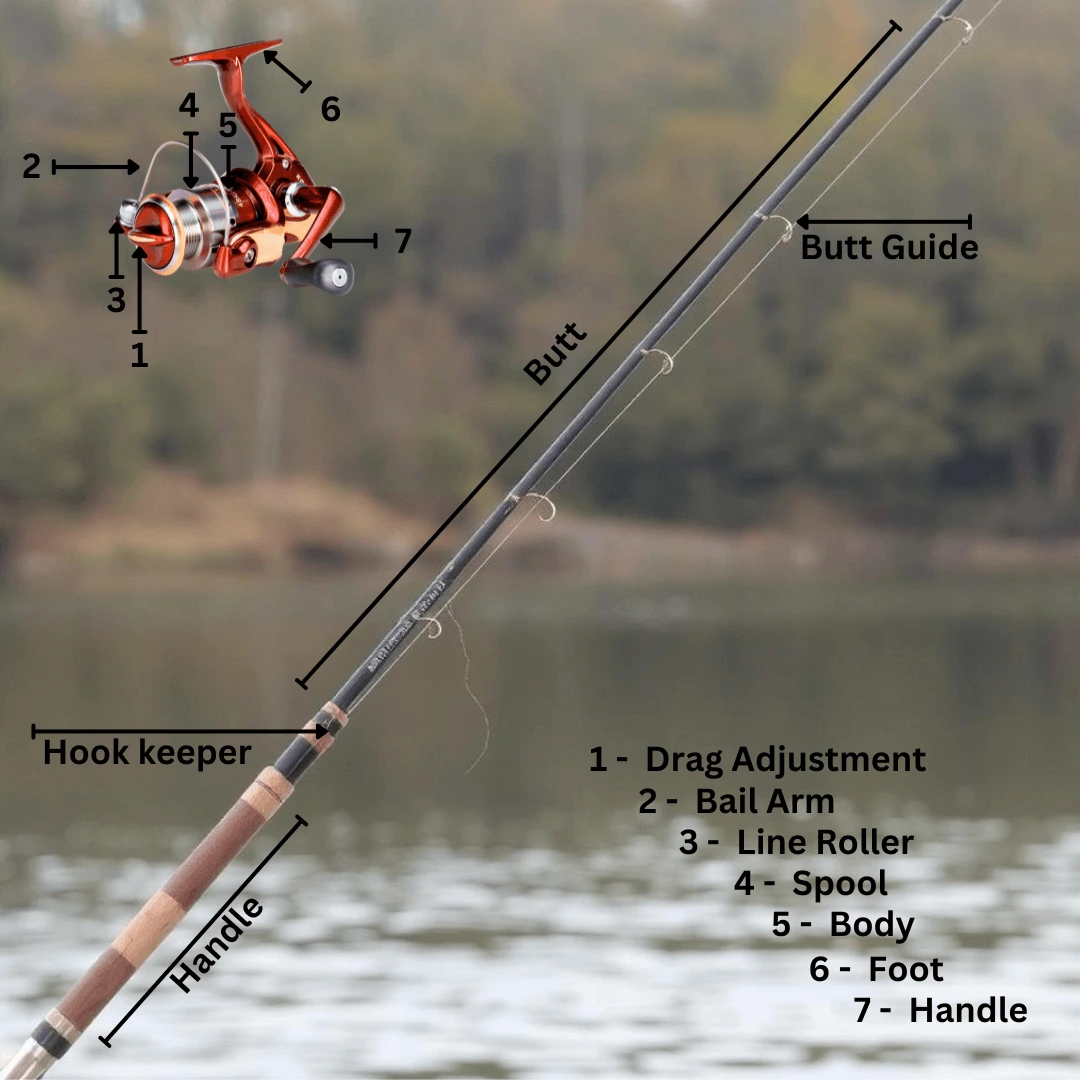
Choosing the right bass fishing gear doesn’t need to be overwhelming. Let’s break it down to the essentials:
- The Dynamic Duo: Selecting Your Rod and Reel
- Spinning Rod and Reel: This is the best setup for beginners due to its ease of use and versatility. Look for a 6’6″ to 7′ medium-action spinning rod. This will provide a good balance of casting distance, sensitivity, and strength. These are ideal for various bass fishing techniques, and they’re great for learning without the frustration of constant line tangles.
- Baitcasting Reels: While these offer extra power and precision favored by more experienced anglers, they come with a steeper learning curve. It’s better to master the spinning reel first before tackling the challenges of a bait caster. Baitcasters are often better for techniques that require greater control and distance with heavier lures but are not recommended for beginners.
- Lines and Knots: The Lifeline to Your Catch
- Monofilament Line: This is the most beginner-friendly option. It’s affordable, stretchy (which helps during hard fights), and easy to handle. Start with an 8-12 lb test line for a good balance of strength and sensitivity.
- Braided Line: This line is incredibly strong and has virtually no stretch, which means you’ll feel even the subtlest bites. It’s great for fishing in heavy cover but can be more visible to fish. Save this for later when you gain experience.
- Fluorocarbon Line: This line is nearly invisible underwater and is ideal for deeper or clear water conditions. It’s also more abrasion-resistant but tends to be a bit pricier.
- Essential Knots: Mastering a few basic knots will make your life much easier. You absolutely must learn the Palomar Knot (ideal for attaching hooks) and the Improved Clinch Knot (great for attaching lures and swivels).
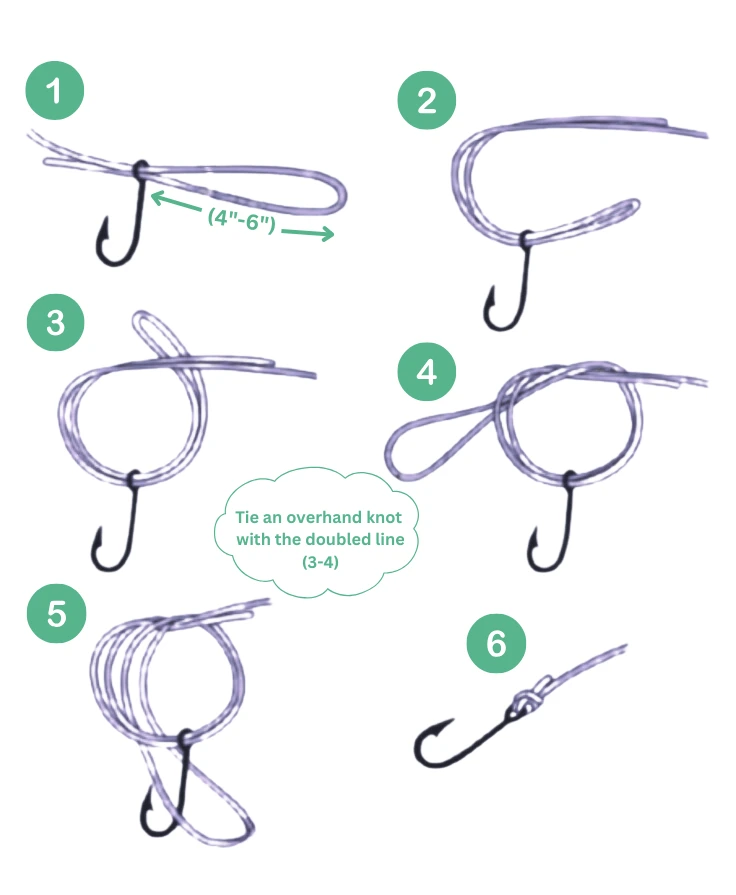
- Your Tackle Box Essentials: A Beginner’s Inventory
- Hooks: You’ll need an assortment of sizes (1/0 to 4/0) to accommodate various lures and baits. Offset hooks, circle hooks, and EWG (Extra Wide Gap) hooks are all good to explore.
- Weights: Bullet weights (for Texas rigs), split shots, and sinkers are all necessary for different rigging techniques.
- Swivels: Barrel swivels reduce line twist, which is a common problem when using certain lures. Consider three-way swivels for specific rigs like drop shot.
- Tools: Pliers (for removing hooks), line cutters (for trimming lines), and a small multi-tool are indispensable.
- Bonus: A measuring tape to measure the sizes of the catch and a scale to measure the weight of a bass.
- Proper Gear Maintenance: Taking care of your equipment will extend its life. After every trip make sure to rinse all your fishing gear with freshwater to prevent any salt or dirt buildup that may cause corrosion. Make sure to also check for any line damages or rod and reel issues. Keep your equipment stored in a dry and safe space away from moisture and high temperatures.
3. Lure Logic: Selecting the Right Bait for the Right Conditions
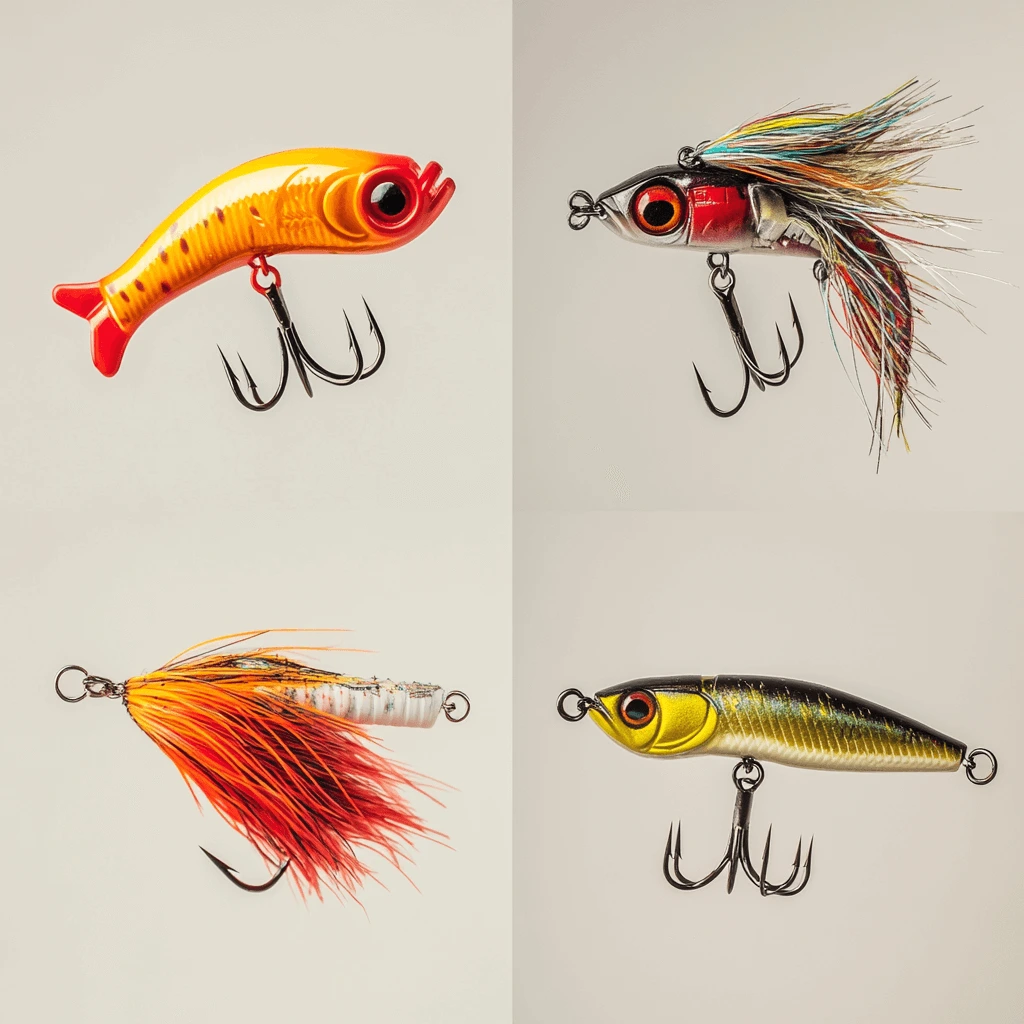
The world of bass fishing lures can seem overwhelming. There are thousands of options out there, but it’s best to start with a few reliable baits and learn how to use them effectively.
- The Beginner’s Arsenal: Four Must-Have Lure Types
- Soft Plastics: These versatile lures include plastic worms, craws, and senkos. They can be fished with various techniques, and they are incredibly effective for attracting bass. They can be rigged in different ways such as Texas rig, wacky rig, Carolina rig, etc. These also come in many different sizes and color combinations.
- Jigs: Jigs are excellent for fishing structures and can mimic crawfish and other bottom-dwelling creatures. They come in different styles such as swim jigs, football jigs, and finesse jigs.
- Crankbaits: These lures are known for their vibrating and wobbling action that attracts bass from a distance. They’re ideal for covering water quickly. Different dive depths are available and need to be matched to the water conditions.
- Spinnerbaits: These lures attract bass with their flashing blades and can be retrieved quickly through the water. Tandem blades, single blades, and willow blades are all options that may be used depending on the water clarity and conditions.
- Matching Your Lures to Conditions:
- Water Clarity: For clear water, use natural colors like green pumpkin, watermelon, or shad. When the water is stained or murky, use brighter colors like chartreuse, fire tiger, or white. You can also use dark colors like black or blue in very dark waters.
- Depth: Use topwater lures and spinnerbaits when the bass is shallow, and switch to jigs and crankbaits for deeper water. When selecting crankbaits, be sure to match the dive depth to your area.
- Live vs. Artificial: While live bait can be effective, it’s generally more difficult to handle and store. Artificial lures are easier to manage, come in a wide variety, and are more beginner-friendly. Once you’ve mastered a selection of artificial lures, then you can experiment with live baits.
4. Mastering the Fundamentals: Essential Bass Fishing Techniques
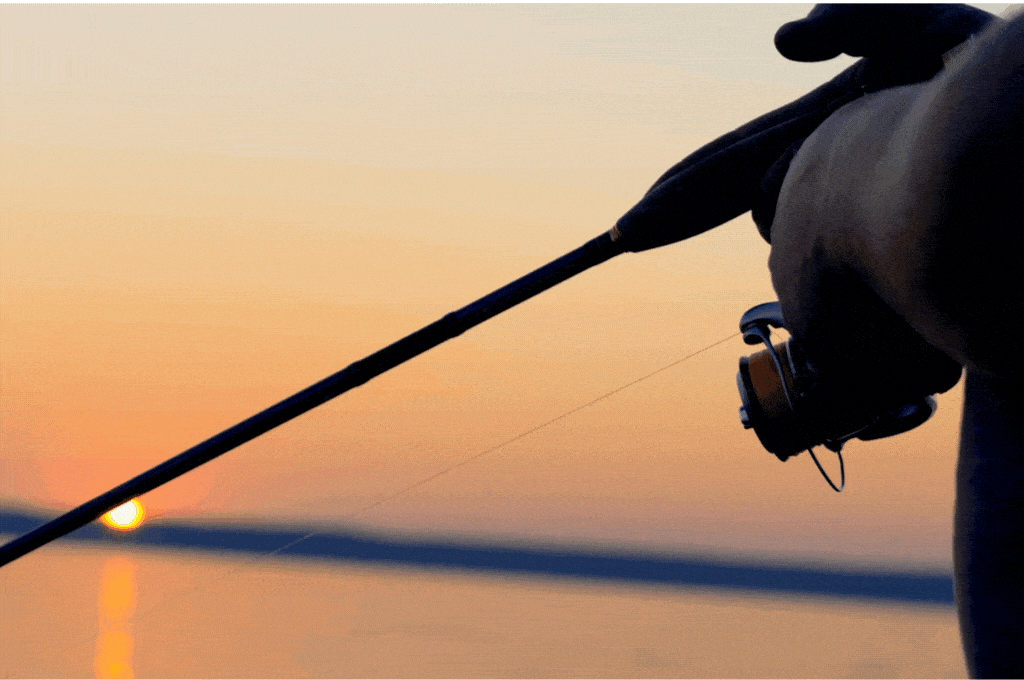
Learning the basic bass fishing techniques will improve your success and make each trip more enjoyable. Let’s dive into some key methods:
- Casting and Retrieving: The Art of Presentation:
- The Basics: Smooth, controlled casts are more effective than wild flings. Start with a basic overhand cast with your spinning reel, and practice for accuracy and distance.
- Retrieval Variations: Change the speed of your retrieve. Incorporate pauses. The best retrieve depends on the bass’s mood and the lure you’re using. If using a crankbait for example try using a stop-and-go motion or a steady retrieve, and for soft plastics, try to vary the speed of retrieve or the way it is rigged.
- Specific techniques for specific lures: For example, spinner baits require steady retrieves for the blades to produce the flashing effect. Topwater lures require twitching and pausing action for optimal performance.
- The Hook Set: Reacting at the Right Time:
- When you feel a bite, react quickly with a firm, upward sweep of your rod tip to secure the hook.
- Be sure to set the hook quickly enough and not to wait to long after feeling a bite, this is one of the most common beginner mistakes.
- Knowing how to feel for different types of bites is crucial to not miss a catch. The feeling of a bite may depend on what type of lure is used, for example, a soft plastic might feel very subtle, whereas a crankbait might feel more like a tugging bite.
- Fishing from Different Spots:
- Shore Fishing: Methodically work along the bank, targeting areas of cover and structure. Be sure not to make sudden movements that can spook a bass.
- Boat/Kayak Fishing: Quietly maneuver into position near prime fishing spots, and minimize your movements to avoid spooking the fish. You can use a fish finder to help locate potential spots.
- Additional Techniques to Learn
- Flipping and Pitching: Flipping and pitching are precision techniques for close-range fishing in heavy cover. This is often done with jigs and soft plastics.
- Jerk Baiting: This is a very effective method that is done with hard plastic lures. This technique is done by jerking your rod with pauses in between, this technique is more effective in cooler water when bass tend to be more sluggish.
- Texas Rig and Carolina Rig are two very popular bass fishing techniques that will get you more catches. Learning about these will significantly improve the chance of landing a trophy.
5. Seasonal Savvy: Understanding Bass Behavior Throughout the Year

Bass behavior isn’t static; it changes dramatically throughout the year. Understanding these seasonal shifts is crucial for your success:
- Spring Spawning: An Aggressive Feeding Frenzy:
- As the water warms up, bass moves from deeper water to shallow, protected areas to spawn. This is the time for the most exciting fishing of the year, as they are often hungry and aggressive. They may be seen in very shallow waters, and they can be seen actively guarding their nests.
- You’ll want to target these areas with lures that mimic nesting baitfish.
- Summer Heat: Seeking Shade and Cooler Depths:
- During the heat of the summer, bass seek the cooler depths of the water. They often congregate around submerged structures such as docks or sunken trees in deeper water.
- You’ll need to adjust to this behavior by switching to deeper water lures and techniques. Be sure to fish in early morning or late evening to catch bass when they are more active.
- Fall Feeding Frenzy: Preparing for the Chill:
- As the water cools, bass become very active again as they feed aggressively, preparing for the winter months. You’ll find them chasing schools of baitfish in shallower areas.
- You’ll want to use faster retrieval techniques with lures like crankbaits and spinnerbaits.
- Winter Slowdown: Deep and Slow:
- In the cold of winter, bass becomes sluggish and lethargic and will often go deep. You’ll have to adjust to this slowdown by fishing more slowly with lures that move at a slower pace.
- Be sure to target stable temperature zones in deeper water. Lures like jigs and soft plastic can work very well in this situation.
6. Catch and Release: Guardians of the Water and the Sport

- Why Catch and Release Matters: A Commitment to Sustainability: Practicing catch and release ensures healthy bass populations for future generations. It’s not just about catching a fish; it’s about protecting the resource we all love. It is important to catch and release bass to protect fish populations and help to keep the ecosystem thriving. The U.S. Fish & Wildlife Service provides valuable resources on responsible angling, helping to maintain healthy bass populations.
- Proper Handling: Minimizing Stress on the Fish
- Wet Hands: Always handle the fish with wet hands to protect their slime coat, which is essential to prevent infections.
- Avoid Holding Vertically: Never hold a bass vertically by its jaw, especially for extended periods as this can damage their organs and spine.
- Handle with Care: Treat every fish with the utmost care and respect.
- Releasing Safely: Giving Them the Best Chance
- Gently place the fish back into the water. You want to give the bass as much time as possible to recover.
- If the bass appears fatigued, hold it gently by its lower jaw and move it back and forth to allow water to flow through its gills. Release it when it is strong enough to swim away on its own.
- Proper Tools for Handling Bass
- Rubberized Nets: Rubberized nets reduce the damage to the bass when caught.
- Fish Grippers: Fish grippers help to secure your fish while taking pictures or removing the hook, however, you should handle the fish carefully.
- Pliers and Hook Removers: Essential tools to remove hooks quickly and carefully.
7. Additional Important Factors
- Fishing Safety: Always be aware of the safety precautions you need to take while fishing. Avoid any alcohol consumption while fishing and always wear a PFD (Personal Flotation Device) while fishing from a boat, kayak, or even from the shore if the water is deep enough. Be sure to be aware of any weather changes while on the water.
- Fishing Laws and Regulations: Be sure to check any local fishing regulations to be sure you are fishing ethically and legally. Be sure to have a valid fishing license and know the limits and types of fish you are allowed to keep. Fishing regulations vary according to location and it is very important to check your local rules.
Conclusion: Your Bass Fishing Adventure Begins Now
You’ve now acquired the foundational knowledge to step confidently into the exciting world of bass fishing. Remember that simplicity and patience are key to success. Don’t be afraid to experiment with different lures and techniques, learn from every trip, and most importantly, enjoy the process. Every cast is a chance to learn, connect with nature, and experience the sheer joy of this amazing sport. What are you waiting for? Grab your gear, head out to your favorite fishing spot, and embark on your very own bass fishing journey!

What are your biggest questions about bass fishing? Have you had any memorable catches recently? Share your fishing stories, ask your questions, and join our growing community of bass fishing enthusiasts in the comments below. Be sure to check out our [related blog posts] on different bass fishing techniques and the best bass fishing lures, and subscribe to our newsletter for more expert tips and resources!
Frequently Asked Questions About Bass Fishing For Beginners
Q: What is the best way for a beginner to get started with bass fishing?
A: The best way to start is by gathering basic gear like a spinning rod, reel, and some common lures. Focus on learning basic techniques like casting and retrieving and be sure to practice and take the time to learn more about bass habits and behaviors.
Q: How do I choose a fishing rod that’s right for me as a novice angler?
A: Look for a spinning rod that’s sensitive yet strong. A medium power, fast-action rod is ideal for beginners and provides enough control while learning to fight a bass. Make sure the rod is not too short (below 6 feet) or too long (above 7’6) for comfortable casting.
Q: What are the most effective lures and baits for bass fishing?
A: Great lures to start with are plastic worms, spinnerbaits, crankbaits, and jigs. For topwater, consider lures such as poppers and buzz baits. Try different lures based on water clarity and depth and the time of year.
Q: Can the time of day affect my bass fishing success?
A: Yes, bass are often more active during low-light conditions. Fish early mornings or late evenings for best results. Weather and spawning season can also significantly affect their activity.
Q: Where are common places I can find bass in a lake or river?
A: Bass-like areas with structures like fallen trees, rocky ledges, and weed lines. They also like to hang around drop-offs and changes in depth. In rivers, look around current breaks and where streams enter. A depth finder can be a helpful tool to locate underwater structures.
Q: Why is catch-and-release fishing important?
A: Catch and release helps maintain healthy bass populations. It allows anglers to enjoy fishing without overharvesting and damaging a fragile ecosystem.
Q: As a beginner, what kind of fishing line should I use?
A: Start with monofilament line. It’s affordable, stretches which gives a bit of forgiveness, and is easy to knot and handle. It’s a great line to learn the basic techniques of bass fishing.
Q: What are the basic techniques I should learn first in bass fishing?
A: Learn to cast well, set the hook correctly, and retrieve lures effectively to mimic live prey. These techniques are essential for beginners and will improve your chance of catching fish.
Q: How does water temperature influence bass behavior?
A: Water temperature significantly changes bass behavior. In cold water, they are sluggish and seek warmer spots. In warm water, they’re more active and hunt in shallower areas. Understanding the water temperature will allow you to select your lures and techniques more effectively.
Q: Are there advantages to bass fishing from a kayak?
A: Yes, kayaks let you fish shallower areas and are quieter, allowing you to sneak up on fish without spooking them. They’re also better for the environment and offer a more peaceful fishing experience. Kayaks are affordable and very easy to transport to many fishing areas.
Q: What are some responsible fishing tips to ensure sustainability?
A: Follow local rules, use eco-friendly gear, and dispose of trash properly. Handle fish gently, use fish handling tools, and participate in habitat conservation. This keeps the sport sustainable for many future generations.
Glossary of Bass Fishing Terms
- Baitfish: Small fish that bass feed on
- Structure: Underwater objects like rocks, trees, and docks
- Cover: Underwater areas like weeds and vegetation that bass use for hiding
- Action (Rod): Rod flex characteristics
- Power (Rod): Rod Strength or stiffness
- Monofilament Line: This is a budget-friendly type of fishing line made of a single strand of plastic.
- Braided Line: This is a type of fishing line that is very strong and is made by braiding multiple thin strands of fiber.
- Fluorocarbon Line: Type of fishing line that is virtually invisible underwater and has low stretch.
- Palomar Knot: Popular fishing knot for attaching a hook to a fishing line.
- Improved Clinch Knot: This popular fishing knot for attaching a swivel or lure to a fishing line.
- Texas Rig: This popular technique uses a weight and offset hook with soft plastic lures.
- Carolina Rig: A popular technique using a weight and swivel with soft plastic lures.
- Wacky Rig: Technique for fishing soft plastic stick baits by hooking it through the middle
- Crankbait: Hard-bodied lures that wobble and move through the water by reeling.
- Spinner bait: Lure with one or more rotating blades.
- Jig: A weighted hook with a skirt that can be fished at different depths.
- Topwater: Lures that stay on top of the water while being retrieved.
- Jerk Bait: Hard-bodied lure that is jerked through the water with pauses in between.
- Drop Shot: A technique with a weight at the bottom and a hook above the weight with soft plastic.
